“Which Espresso Machine Should you Buy?” — That’s the question I asked myself years ago when I first decided to bring café-quality coffee into my own kitchen.
Choosing an espresso machine isn’t just about picking a shiny gadget; it’s about shaping how your mornings begin and how your coffee feels with every sip.
Over time, I’ve tested everything—from affordable semi-automatics to high-end dual boilers that could rival professional setups. Some made me smile with perfect crema; others made me question my life choices before 8 a.m.

In this guide, I’ll help you skip those trial-and-error moments. You’ll discover which espresso machine you should buy:
-
What to look for before investing in a coffee machine
-
Brand comparisons and my personal favorites
-
Honest reviews based on real, hands-on experience
-
Step-by-step instructions for brewing and cleaning
-
Must-have accessories and maintenance tips
-
My final, expert recommendation
By the end, you’ll confidently know which espresso machine you should buy—one that fits your style, space, and taste. So, grab your mug, and let’s brew smarter, not harder.
Buying Guide—What I Look for in an Espresso Machine
When I shop, I ask, “Which machine will help me make better coffee regularly without frustration?”
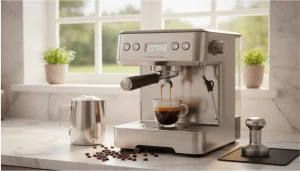
Here are the key features I always check:
Machine Type & Automation Level
Espresso makers are available in four different automation levels: manual, semi-automatic, automatic, and super-automatic. Control, convenience, and learning curve are all trade-offs for each.
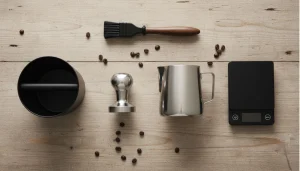
Depending on how hands-on they want to be, many buyers select between manual, semi-automatic, and super-automatic machines, according to Clive Coffee’s guide.
- Manual/lever machines give full control but require skill.
- Semi-automatic machines let you control extraction, but you’re still involved.
- Super-automatic/bean-to-cup machines do almost everything for you.
Before anything else, decide how much control you want.
Boiler & Brewing System
The internal boiler design affects flexibility. Key types include:
- Single boiler: One boiler handles both brewing and steaming. You must wait between brewing and frothing.
- Heat exchanger: One boiler, but the system allows simultaneous steaming and brewing (with tricks).
- Dual boiler: Two independent boilers—one for brew, one for steam. Great for milk drinks.
If you love lattes or cappuccinos, a dual boiler or heat exchanger system is more forgiving.
Temperature Control (PID) & Stability
Stable temperature is crucial for consistent espresso. Machines with PID (proportional-integral-derivative) control give more precise temp adjustments.
CoffeeGeek ranks PID systems among the top considerations when buying.
Good PID control helps reduce over- or under-extraction, especially when experimenting with different beans.
Build Quality & Parts/Serviceability
You want a machine you can keep for years. Look for:
- Stainless steel or metal body
- Easy access to internal parts
- Availability of spare parts
- Good after-sales service
Grinder & Compatibility
Your machine is only as good as the grind you feed it. A quality grinder is often more important than the espresso machine itself.
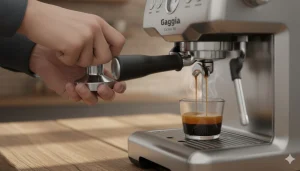
As shared on r/Coffee: “Allocate 50% of your budget to a grinder. The right grinder often improves shots more than a high-end machine.”
Some machines have built-in grinders; many don’t. You’ll need a good burr grinder if it lacks one.
Space, Size & Water Supply
Don’t pick a giant machine if your counter is tiny. Check:
- Machine width, depth, height
- Water reservoir capacity
- Whether it can be plumbed to the water line
- Drain or drip tray size
Also consider how easy it will be to avoid spillage in tight corners.
Budget and Value Over Time
Set a realistic budget early. As Seattle Coffee Gear advises:
“You generally get what you pay for in espresso machines.”
But don’t overspend on features you won’t use. Also, leave a margin for a good grinder, accessories, and maintenance.
Brand Comparisons—Which Brand Fits You Best?
Below is how I compare popular espresso machine brands, based on my hands-on testing.
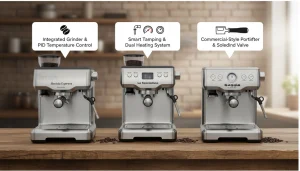
Breville vs De’Longhi
- Breville: Great balance of control, features, and user-friendliness. Many models include PID, volumetric settings, and good steam wands.
- De’Longhi: Often more affordable, compact, and suitable for daily use. May offer fewer premium controls but good value.
Gaggia/Rancilio vs Semi-pro Brands
- Gaggia/Rancilio: Well-known for sturdy, commercial-like home machines. Good for those wanting to grow into barista skills.
- Higher-end brands (like Lelit and Profitec) appeal to hobbyists who want top-tier performance and are okay with tinkering.
Automatic vs Manual-focused Brands
- Jura, Saeco, and Philips focus on super-automatic machines—push-button, minimal involvement.
- Classic lever/pump brands: Breville, Rancilio, and La Marzocco—aimed at craft control.
Each approach has merits—choose based on how much barista work you enjoy.
Top Espresso Machine Recommendations & Reviews
Here are several machines I’d personally pick today, in different categories:
Breville Barista Express (Semi-Automatic)
- Offers a built-in grinder, PID, and a good steam wand.
- Excellent all-in-one for home baristas who want control without extra purchases.
Breville Bambino Plus
- Compact, fast to heat, auto steam wand.
- Ideal for small kitchens or minimalists.
De’Longhi Dedica
- Slim footprint, espresso, and milk-foaming capabilities.
- A good option for newcomers wanting classic espresso and cappuccino.
Gaggia Classic / Gaggia Classic Pro
- Durable, metal build, a good option for developing barista skills.
- Requires an external grinder but delivers a strong espresso.
Lelit Bianca / Profitec Pro 800
- Premium dual-boiler machines with advanced controls.
- For enthusiasts who want fine control, consistency, and upgradeability.
Each machine balances trade-offs. Some favor automation; others favor manual control.
How-to Guides – Use & Clean Your Espresso Machine
Mastering use and cleaning is as important as choosing the right machine. Here’s how I do it:
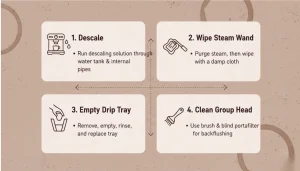
How to Use an Espresso Machine (Basic Workflow)
- Warm up the machine fully (15–20 minutes).
- Dose and tamp coffee evenly.
- Lock the portafilter and start the shot (aim for 25–30 seconds).
- Steam milk (if applicable) using proper technique.
- Serve immediately, then purge the steam wand.
How to Clean Groups, Portafilter & Steam Wand
- Backflush with a blind filter and a cleaning tablet weekly (for machines with a 3-way valve).
- Rinse the portafilter and baskets daily.
- Wipe and purge the steam wand after every use to prevent milk residue.
- Descale periodically as per machine instructions (especially in hard water areas).
Deep Maintenance Tasks
- Check gaskets and replace when worn.
- Lubricate moving parts if the machine design allows.
- Check and calibrate the thermostat or PID settings if shots start drifting.
Proper cleaning preserves flavor and extends machine life.
Accessories & Maintenance Tips
Here are the extras I always include with a machine and the care habits I follow:
Must-Have Accessories
- Quality burr grinder (separate or built-in).
- Tamper & distribution tools.
- Milk pitcher (stainless).
- Scale (0.1 g accuracy).
- Knock box for spent puck disposal.
- Cleaning tablets & brushes.
Maintenance Habits That Matter
- Flush the group head with water before brewing.
- Use filtered water to reduce scale buildup.
- Replace gaskets every 1–2 years.
- Keep access panels open occasionally to air out internals.
- Don’t let coffee sit in the portafilter too long.
With regular care, your espresso machine can last many years.
Final Thoughts: Which Espresso Machine Should You Buy?
After years of testing, experimenting, and spilling more espresso shots than I’d like to admit, the Breville Barista Express is the one I’d choose today. It strikes the perfect balance between value, convenience, and control—a rare combination that suits both beginners and passionate home baristas.

However, the best espresso machine ultimately depends on your personal style:
- ☕ Prefer one-touch simplicity? Go for a super-automatic machine—it does all the work while you enjoy your coffee.
- 🎨 Love experimenting and mastering technique? A semi-automatic or dual-boiler machine gives you the hands-on experience you’ll appreciate.
- ⚙️ No matter your choice, always pair it with a quality grinder and give it proper care. A clean, well-maintained espresso machine can last for years and consistently deliver rich, balanced coffee.
In the end, espresso is more than a drink—it’s a ritual. It’s both science and art, measured in pressure, grind size, and passion. When you choose wisely and stay consistent, every cup becomes a small, satisfying victory.
FAQ—Quick Answers for Which Espresso Machine Should You Buy
Q1: Do I need a high-end machine to get good espresso?
No. Even mid-tier machines (if paired with a good grinder) can deliver satisfying shots.
Q2: Which is more important: the machine or the grinder?
Grinder. A great grinder improves your espresso more than a marginally better machine.
Q3: Auto or manual—which should I choose?
If you enjoy hands-on crafts, semi- or manual machines are ideal. For convenience, go automatic or super-automatic.
Q4: How often should I descale?
Every 2–4 months, depending on water hardness.
Q5: Can I steam milk with all machines?
No. Some machines (especially pod or entry-level) lack steam wands. Check specs first.